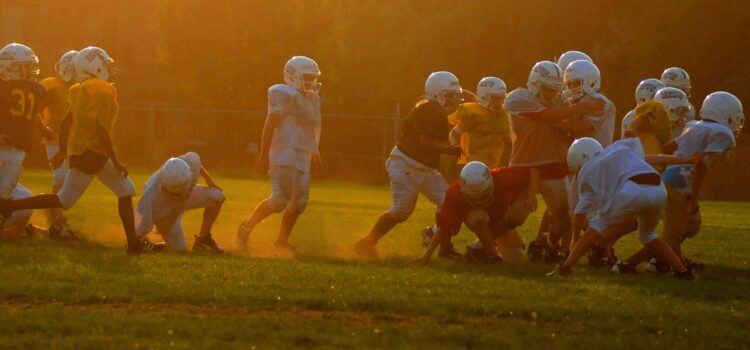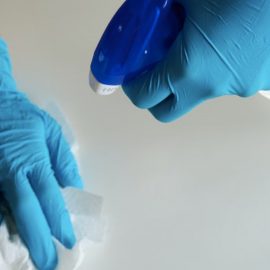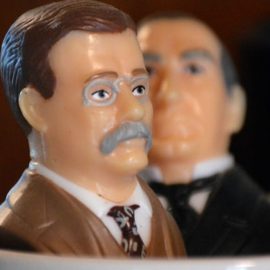

This article is an excerpt from the Shortform book guide to "The Blind Side" by Michael Lewis. Shortform has the world's best summaries and analyses of books you should be reading.
Like this article? Sign up for a free trial here .
What was Michael Oher’s recruiting process like? What colleges tried to recruit Oher?
For Michael Oher, recruiting started late. When Tom Lemming saw a video of Oher playing, no one had ever heard of him, though he excelledin sports at Briarcrest.
Read more about Michael Oher, recruiting, and how he became a top prospect for college football
Michael Oher: Recruiting Begins
Everybody knew that Michael was big, but no one was aware of his other talents at first. John Harrington was the first to notice that Michael was more than just a giant. The first time Michael walked into the basketball gym to observe practice, John did what he always did when a new kid entered his practices—threw Michael the ball. John didn’t expect to see this 300-pound kid dribble between his legs, spin, and sink a three-pointer from the deep corner like he was a 6-foot point guard.
The track coach, Mark Boggess, wandered onto the football field one day, where Michael was by himself with a bag of footballs. One after the other, Michael stood at the 50-yard line and threw the balls between the endzone goalposts. Each throw was perfect and traveled around 70 yards, which was 10 yards farther than the average quarterback could throw.
Then, it was Coach Hugh Freeze’s turn to see Michael in action. During football practice, Michael wandered onto the field and picked up a 50-pound tackle dummy and ran with it at high speed like it was no more than a child’s doll. Hugh also couldn’t believe how fast Michael was for his size and had him weighed. After finding a scale that could hold Michael (a cattle scale), they learned Michael weighed a whopping 344 pounds, or the equivalent of a slim cow.
All of these coaches could tell that Michael had a raw physical talent. The only problem—the giant sophomore was still ineligible for sports.
A Slow Start
After discovering that Michael could learn and pass his classes if the lessons were developed properly for him, Principal Simpson determined that Michael could stay at Briarcrest. He took him off of probation after the first semester and allowed him to play sports. Michael joined the basketball team toward the latter part of his sophomore year and moved to track and field afterward. At the beginning of his junior year, he was finally able to play football.
Michael excelled at track and field but struggled on both the basketball and football teams at first. Part of the issue was his lack of aggression, which made him weak defensively in both sports. Neither coach could figure out why this huge kid was so docile. Most kids who come from traumatic backgrounds have an inherent aggression that gets channeled through sports. Football, especially, provides these kids opportunities to express their rage in a productive way, but Michael never did. He lacked that aggressive fire, and his teams suffered for it.
In track and field, Michael participated in field events, like discus and shot put. Michael had no training in either event when he competed in the first meet, but his strength and ability to mimic others’ physical movement helped him come in first. That was the moment Coach Boggess realized Michael learned by watching movement. He started showing him performance videos of high-quality field athletes, and by the end of Michael’s track career at the school, he broke the West Tennessee sectional record in the discus and almost broke it for the shot put.
His success as a basketball player would come a different way. Skills and talent weren’t enough to keep Michael in the games his sophomore or first half of his junior year. His lack of defense and inability to play the post position hindered his contributions to the team. Michael thought he was a guard and kept shooting from the outside, instead of posting below the basket.
Then, the team took a trip to Myrtle Beach for a holiday tournament during his junior year, and Michael found his fire. The opposing team’s fans harassed Michael and yelled racial slurs at him. Michael grew angry and didn’t handle it well. He became overly aggressive and, at one point, turned and flipped off the fans. And then something changed. Michael channeled his aggression into action and stayed in his post position. He ended up pulling down 15 rebounds and scored 27 points.
It would take longer for Michael to find his niche in football. The first several games of his junior season were poor. He played defensive tackle because of his speed, but his inability to hit anyone made him virtually invisible on the field. His best contribution was to intimidate the other teams with his size, but that faded when they saw Michael play. In fact, Michael was so docile on the field that he had a meltdown when he cut his hand on another player’s face mask. The mask had sliced the webbing between his fingers down to the bone.
Michael ran off the field screaming like a small child, and he wouldn’t let anyone look at his hand. Leigh Anne was in the stands and watched the coaches fail to calm Michael down and attend to his hand. She walked down to the field, marched over to Michael, and ordered him to show the coaches his hand. He slowly opened his bloody fist and exposed the wound. There was no doubt about it: Michael would have to go to the hospital for stitches.
The athletic trainer took an anxious Michael to the hospital. He was taken to the back to get stitched up, practically having to be dragged there by the nurses. Then, a scream that shook the walls was heard. When the trainer reached the room, Michael was dodging and weaving away from the nurses and doctor trying to give him a local anesthetic shot. That’s when the trainer realized Michael had never been in a hospital or seen a needle in his life. Once again, the trainer called Leigh Anne, and once again, she ordered Michael to let the doctors fix his hand.
The Freak of Nature
Sean and Leigh Anne knew that Michael’s grades would not be enough to get him into college, but maybe sports could. Sean had some contacts at Division II schools and wrote letters on Michael’s behalf regarding his abilities as a basketball player. They also signed him up for summer basketball camps to improve his skills. What they didn’t know was that Hugh Freeze had sent Tom Lemming a video of Michael playing football. But Michael Oher’s recruiting process was not easy, and hestruggled to be academically eligible.
The day of Lemming’s visit, Michael met with him out of obligation to Coach Freeze, but he had no interest in pursuing football and just wanted to leave. Yet despite how that meeting went, Lemming still wrote in his scouting report that a large junior in Memphis was the most promising left tackle he’d seen since Orlando Pace. Pace had been chosen by Lemming as an All-American pick years before and was now making $10 million a year in the NFL. This was the first big step in Michael Oher’s recruiting process.
A week later, the Briarcrest football team held two weeks of spring training practice. At the first practice, the Briarcrest coaches and players noticed a group of similarly dressed men huddled in a corner of the field. They were assistant coaches at top Division I college programs, an unfamiliar sight for the likes of Briarcrest. No one really knew why they were there, but it became clear after they saw Michael in action.
The first drill they did was called the board drill, where an offensive lineman and defensive lineman face off on a wooden board to see who can push the other off. Michael was chosen as the offensive lineman, and a 270-pound star in his own right, Joseph Crone, faced off with him. The whole drill was over in a matter of seconds. Michael picked Joseph up like he weighed 10 pounds and carried him down the field.
This is when Michael Oher’s recruiting process really accelerated. The phones opened with a flurry that day in 2004, and the assistant coaches scrambled to explain what they’d just seen to their head coaches. The assistant coach from Clemson actually handed Hugh Freeze his card and indicated that Michael could have whatever he wanted to come play for Clemson. The Briarcrest coaches were baffled. They’d never seen this type of performance from Michael before. Even Sean was impressed. He didn’t know Michael was any good at football.
After that day, coaches from all over the country, as far away as Oregon, started showing up at practices. Some knew they had no shot at recruiting Michael, but they wanted to see this freak of nature with their own eyes. Shortly after, Lemming wrote that Michael was a pre-season First Team High School All-American candidate, and the vultures began to circle even more.
No one could explain why such a big deal was being made over a player who hadn’t yet proven he was any good in a game and had an unclear history. Not even Coach Freeze understood until the college coaches started talking about the left tackle. With his size, speed, and agility, Michael was the perfect body type for the position that had gradually grown to the second-most important and highest paid in the NFL. After he discovered this, Freeze moved Michael from right tackle to left to cover the quarterback’s blind side. Michael Oher’s recruiting process could finally begin.

———End of Preview———
Like what you just read? Read the rest of the world's best book summary and analysis of Michael Lewis's "The Blind Side" at Shortform .
Here's what you'll find in our full The Blind Side summary :
- How Michael Oher went from the projects in Memphis to the NFL
- Why the combination of size and speed became essential for football stars
- How Oher was taken in by the wealthy Tuohy family






